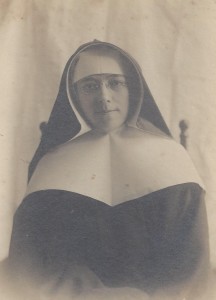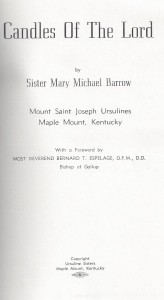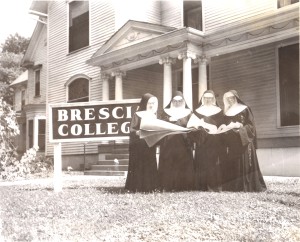May 21 marks the 57th anniversary of the death of Sister Mary Michael Barrow. The archives recently acquired a 16 page handwritten biography of Sister Mary Michael by an unknown author. Shortening the biography a bit, her story is completely fascinating as she accomplished achievement after achievement, all the while having a severe physical handicap. Enjoy reading about Sister Mary Michael!
Sister Mary Michael Barrow OSU
Sister Mary Michael Barrow OSU (1880-1956) was born June 23, 1880 to Mary Elizabeth Curry Barrow and David Gilliam Barrow, their tenth child, to whom they gave the name Mary Elizabeth.
Records indicate that the early history of this family developed in Missouri, probably Johnson County, prior to the Civil War. It is recorded in Clark County, Kentucky that on April 15, 1859, Elizabeth Floyd Curry was married to David Gilliam Barrow. The Barrows lived in Missouri from 1859 to 1862. At the time of the marriage clouds of war were gathering. Depending upon a young man’s leaning in sympathy for the cause of the Union or that of the South, many moved from the neutral state of Kentucky to a state where changes might be better for enlistment with the fighting forces of their choice.
It was in Missouri in 1862 that David Barrow succeeded in joining the Confederate forces. Meantime, plans had been made for Mrs. Barrow’s safe return to her family in Montgomery County, Kentucky, upon the departure of her husband for service with the military. There were now two small children, Napoleon aged two, and an infant daughter Elizabeth. The party traveled horseback with the mother carrying baby Elizabeth in her arms. The baby soon became ill and before many days, Mrs. Barrow was traveling east with empty arms, having been forced to leave little Elizabeth beside the trail in a nameless grave in Missouri. At length, David Barrow, upon discharge from the Confederate Army, joined his family and shortly moved them to Clark County, settling on a farm about ten miles from Winchester. Through the years following, there were born to the Barrows Elias (1864), William Carroll (1866), Annie Goodwin (1868), Adeline (1870), Thomas Marshall (1873), Junie Etta (1876), and in 1878 a boy, stillborn.
In those remote years, Eastern Kentucky was still Mission Country where an itinerant priest periodically visited the communities, bringing the sacraments and offering the Holy Sacrifice of the Mass in the homes of Catholic families. The Barrow farm home was one of the mission stations.. So it was that the future Sister Mary Michael was baptized in her own home by the missionary priest who came to minister to the spiritual needs of the community. She received the name of Mary Elizabeth in the presence of her parents, four elder brothers and three elder sisters. Two children having died earlier, this youngest addition was the tenth child but she did not remain the youngest. Five years later the Barrow home was blessed with the arrival of Robert Wellington, completing the family. Death visited the Barrow home in January 1888, taking the mother and leaving David Barrow to be both father and mother to his family. Soon thereafter he moved the family to Fayette County and established the home on a farm about five miles from Lexington.
When Mary Elizabeth was quite young, perhaps about two years of age, she fell prey to a very severe and mysterious ailment. Insofar as medical knowledge had developed, the symptoms were though to resemble meningitis. Though scientific assistance was not available to benefit Mary Elizabeth in this remote area of Kentucky scarcely removed from frontier days, she survived the illness only to be physically crippled the remainder of her days stretching over nearly 75 years. Her ability to walk was plagued by a seriously deformed ankle resulting from the malady she had suffered. Each step caused a jerking of bodily muscles, especially those of the spine, resulting in great pain and making walking an agonizing ordeal. Though there was no relief available for pain or for handicap, she was not daunted and Mary Elizabeth graduated from the high school program of St. Catherine’s Academy in Lexington, Kentucky in 1896 at the age of 16. This was the year that the Barrow family took up residence in Owensboro, Kentucky.
It is known that she taught in the elementary schools of Daviess County for a number of years between 1896 and 1906. It is also known that Miss Barrow taught at a school in the area which lies today between Ford and Booth Avenues. Mary Elizabeth Barrow was a devout Catholic and for a goodly number of years she had fostered an ardent hope that she might enter the religious life. She fought relentlessly against the fear that because of her crippled physical state she might never be accepted by a religious order. She had sought admission to the community of the Sisters of Charity of Nazareth, Kentucky. Though she had received her education from them at St. Catherine’s Academy, her application was rejected. But she did not give up. She had the very good fortune to find a spiritual advisor in the person of Father George M. Connor, assistant pastor at St. Paul’s Parish, Owensboro, under Father Edward M. Fitzgerald. Father Connor encouraged her in the pursuit of her so greatly desired but ever elusive goal even to the point of allowing her to receive Holy Communion daily, a practice then uncommon. Before long, Mary Elizabeth’s prayers were answered when she was accepted to the Novitiate at Mt. St. Joseph Motherhouse. In due time it came to pass that in 1906 at the age of 26, Mary Elizabeth Barrow became Sister Mary Michael, OSU.
Having already a number of years to labor in the classroom, she was well qualified for assignment to a wide range of teaching duties in the many schools, elementary and secondary, which Mt. St. Joseph staffed at the Motherhouse, throughout all the Diocese of Louisville (the Diocese of Owensboro had not yet been established) and in a number of public schools of Kentucky; also, beyond the borders of Kentucky, the Ursulines staffed, as the years passed, an increasing number of schools, public and private, in other states.
The year was about 1926 and marked the completion of something like thirty years of strenuous labor. Already advanced beyond the mid-fifth decade of her life, Sister was a very physically tired woman, but not mentally. Reverend Mother urged her to seek a thorough physical examination and, above all, to take a long, well-earned rest.
From the hands of two of the most accomplished physicians and surgeons in Kentucky, Sister Mary Michael received an extensive medical evaluation. The long delayed diagnosis of her devastating illness in infancy was poliomyelitis. Thinking they were doing Sister a favor, her doctors prescribed retirement to the Motherhouse, there to forego any thought of return to the classroom. She continued to let her physicians know that she had a hope that, at least, an attempt at correction of her orthopedic condition might become possible. At length the day came when her doctors came to her bedside, apparently for the routine professional visit. However, the doctors revealed to her a surgical design which they had created which was a corrective procedure. Through this surgical effort they hoped to anchor the foot in the normal position and further stabilize the ankle joint with braces built into a specially constructed shoe. An overjoyed Sister Mary Michael accepted the plan without question. After many months and many operations, the final result was a tremendous improvement in the mechanism of walking which brought a great reduction in the pain experienced since infancy.
Home once more at Mt. St. Joseph, Sister Mary Michael entered into and became absorbed in the work at hand. Prior to departure for studies at Catholic University of America, Sister had been an active member of the staff preoccupied with organizing a program acceptable to the Kentucky State Legislature for the granting of degrees. The Ursulines of Mt. St. Joseph had spent the years of the early 1920s planning, organizing and bringing into operation Mt. St. Joseph Junior College. Comprised at the Motherhouse, this tiny mustard seed planted in 1925, was to grow and blossom 25 years later as Brescia College [later University], a four year Liberal Arts college in Owensboro, Kentucky.
Through the years of the early 1930s Sister Mary Michael taught history and science at the Junior College. Frank Schadler, the only male graduate of Mt. St. Joseph High School, says that her presentation of periods of history – events, battles, treaties, disputes, etc. – made you feel that she had been present, even a participant, in it all.
Sister Mary Michael stands at the bottom left in this Waterflow group photo from the 1940s.
When New Mexico was admitted to the Union in 1912, already three native sons of Kentucky and Daviess County had migrated to that far away land. They had settled in San Juan County on a beautiful mesa overlooking the San Juan River, about fifteen miles from Farmington. For many years these three stalwarts held out in spite of drought, floods, and crop failures. As the years went by, many men and families came to join the three, until there was a thriving colony living on what had come to be known as Waterflow. Many residents were relatives of the Sisters of Mount Saint Joseph community. Naturally, the parents wished Catholic education for their children, and it was natural that they should urge the Ursulines of Mt. St. Joseph to expand their mission of “education of girls” to include an educational apostolate to the “home-folk,” now transplanted to New Mexico. In answer to this summons, by September 1919 three schools had been established: Blanco, Farmington, and Waterflow.
It was to this place, in the summer of 1935, that Sister Mary Michael was appointed superior of the sisters at Sacred Heart Convent and principal of Sacred Heart Academy, grade, and high school. Sister remained at Waterflow for ten years teaching, organizing, directing, improvising, upgrading, developing the school and educational offerings, guarding the purse, and counseling the pupils and their parents.
Meantime, Sister Mary Michael had written a fascinating account of the 25 year mission venture, her fertile mind grasping the parallel of the Yucca with the Ursuline in New Mexico weaving a tapestry of the “saga” of the Daughters of St. Angela Merici bringing the light of learning and faith. Her book Candles of the Lord was published by Our Sunday Visitor Press in 1946.
Title Page
Again at home in Kentucky in 1946, Sister Mary Michael was not slow to discern that the 20 year old Junior College had not progressed as might be hoped. Mt. St. Joseph, tucked away in a rolling landscape could be easily overlooked. One idea was to offer courses from Mt. St. Joseph High School in Owensboro, faculty members communing from the Mount. But Mt. St. Joseph Junior College was a boarding and day women’s college. Sister Mary Michael argued that returning servicemen would be eligible for the G.I. Bill which included educational benefits. If no collegiate education were offered in nearby Owensboro, these men would go to college elsewhere. Soon four faculty members were commuting to Mt. St. Joseph’s School to hold extension college courses. Enrollments were so encouraging that soon a home was purchased and christened Brescia Hall, honoring the original home of Ursuline Sisters at Brescia, Italy. When in 1948 the Southern Association of Colleges and Secondary Schools recommended that he program being offered at Brescia Hall be absorbed by Mt. St. Joseph Junior College, this merger was effected and Sister Mary Michael was given charge of students at Brescia Hall and appointed Registrar. Enrollments increased so much that within a couple of years the work at Brescia Hall had become forbidding for the small staff assigned from the Mt. St. Joseph campus. Faculty members were commuting daily to Brescia Hall while the need for a larger staff and more classrooms to relieve Brescia Hall had become crucial. Sister Mary Michael had many matters to refer to Bishop Cotton, as she was also custodian of property and funds, a thing that goes with “being in charge.” She always greeted the Bishop with, “Bishop Cotton, when are we going to move the college to Owensboro?”
Sisters survey plans for Brescia College in 1955.
At last, on October 5, 1950 a cornerstone was laid implying that Sister Mary Michael’s pleadings and prayers were bringing results; that Mt. St. Joseph Junior College was being transplanted and named anew – Brescia College – and endowed with the potential to blossom presently as a four year co-educational Liberal Arts college.
Brescia was Sister Mary Michaels’ “swan song.” In 1951 at the age of 71, she retired, but not to seclusion. She made a trip with Mother General back to her beloved Waterflow to renew old acquaintances and to garner new ones. She kept dutifully in touch with the members of her family and with all descendants of the Curry-Barrow line. She never forgot friends who needed her. Sister Mary Michael was called home by her Lord and Master on May 21, 1956 at the age of 76 and in the 50th year of her religious life.



